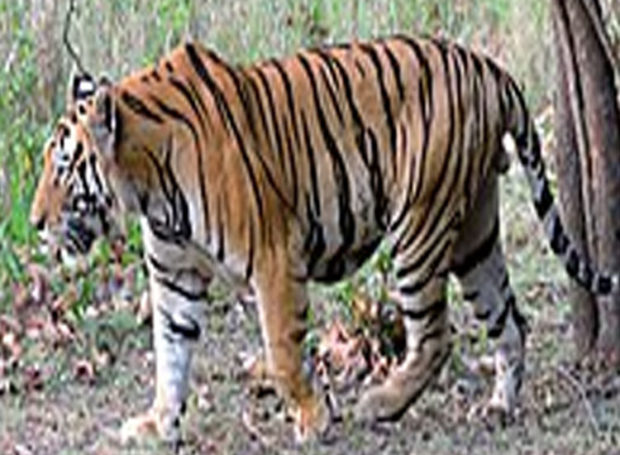
35% of India’s tiger ranges are outside protected areas: Report
PTI, Jul 9, 2021, 5:12 PM IST

Source: Wikipedia
New Delhi: Thirty-five percent of India’s tiger ranges are outside protected areas and human-animal conflict affects over 75 percent of the world’s wild cat species, according to a new report.
The study, which has been done by WWF and the United Nations Environment Programme (UNEP) with contributions from 155 experts from 40 organizations based in 27 countries, also stated that human-wildlife conflict is the greatest threat to animals.
”Currently, 35 percent of India’s tiger range, 40 percent of the African lion range, and 70 percent of the African and Asian elephant ranges are outside protected areas,” said the report — ‘A future for all-The need for human-wildlife coexistence.’
”Marine species, such as turtles and whales, that travel thousands of kilometers annually, are also increasingly interacting with people. With so much overlap, effective HWC (human-wildlife conflict) management becomes increasingly necessary,” it said.
The report said that human-wildlife conflict — when struggles arise from people and animals coming into contact — often leads to the killing of animals in self-defense or as pre-emptive or retaliatory, which can drive species to extinction. ”Marine and terrestrial protected areas cover only 9.67 percent of the globe, and most of these protected areas are disconnected from each other. Therefore, many species depend on human-dominated spaces for their survival, and shared landscapes where both humans and wildlife exist outside protected areas play an increasingly important role for the survival of key species such as large predators and herbivores,” the report said.
It said that many other terrestrial and marine carnivore species such as polar bears and Mediterranean monk seals and large herbivores such as elephants are also getting affected due to HWC.
”In India, data from the Ministry of Environment, Forest and Climate Change indicates that over 500 elephants were killed between 2014-2015 and 2018-2019, most related to human-elephant conflict. During the same period, 2,361 people were killed as a result of conflict with elephants,” the report said.
According to it, India faces an increasing challenge of human-wildlife conflict, which is driven by development pressures. ”With the world’s second-largest human population along with the largest wild populations of tigers, Asian elephants, One-horned rhinos, Asiatic lions, and other globally threatened species, India faces urgent problems of human-wildlife conflict that must be addressed to achieve a socially just form of conservation. India’s elephants probably embody the problem the best,” it said. Elephants in India are restricted to just three-four percent of their original habitat, with their remaining range plagued by deforestation, invasive species, and climate change. This is pushing elephants to seek resources outside of forests and protected areas, the report said. ”As a result, marginalized people face the brunt of elephants’ increasing reliance on crops. As many as 500 people are killed by elephants, and thousands of families face crop and property loss to elephants annually,” it said.
Margaret Kinnaird, Global Wildlife Practice Leader at WWF said the global wildlife population has fallen by an average of 68 percent since 1970.
”Within a human lifetime, we have already seen extraordinary and unparalleled changes to our planet. Global wildlife populations have fallen an average of 68 percent since 1970. Human-wildlife conflict, in combination with other threats, has driven the significant decline of species that were once abundant, and species that are naturally less abundant have been pushed to the brink of extinction,” Kinnaird said. Unless urgent action is taken, this devastating trend will only worsen, wreaking detrimental and, in some cases, irreversible impacts on ecosystems and biodiversity, Kinnaird said.
According to Director of UNEP’s Ecosystems Division Susan Gardner, this report is a clarion call to elevate the problem of HWC and give it the attention it deserves in national and international processes.
”It is a call for the adoption of approaches that identify and address the deeper, underlying causes of conflict while developing systemic solutions with affected communities as active and equal participants in the process. As demonstrated in many of the case studies in this report, coexistence is both possible and attainable,” she said.
The report said that ”while people the world over reap the benefits of maintaining flourishing wildlife populations – healthy ecosystems that allow us to survive, provide food and enable livelihoods – catastrophic impacts such as injury and death and the loss of property and livelihoods put tremendous stress on those who live alongside wildlife, often in developing nations rich in biodiversity, leading to financial insecurity and poor physical and mental health”. It said completely eradicating human-wildlife conflict is not possible but that well-planned, integrated approaches to managing it can reduce conflicts.
”An example of this can be seen in Sonitpur District, Assam, where large-scale deforestation and degradation were driving increases in elephant crop-raiding that led to accidental human deaths and retaliatory killings of elephants,” it said. WWF India during 2003-2004 developed the Sonitpur Model by which community members were connected with the state forest department and given training on how to work with them to drive elephants away from crop fields safely and human habitations.
Udayavani is now on Telegram. Click here to join our channel and stay updated with the latest news.
Top News

Related Articles More

Congress’ guarantees implemented in Karnataka amid BJP’s false propaganda: Shivakumar

Followers of Sanatan Dharma will respond to those disrespecting it: Pawan Kalyan

Priyanka Gandhi leads roadshow in Nagpur

Sitharaman responds to X user seeking relief for middle class

Actor-singer held with MDMA, ganja
MUST WATCH
Latest Additions

Congress’ guarantees implemented in Karnataka amid BJP’s false propaganda: Shivakumar

Followers of Sanatan Dharma will respond to those disrespecting it: Pawan Kalyan

Pushpa bows down to no one, but will do so for you: Allu Arjun to fans at ‘Pushpa 2’ trailer launch

Priyanka Gandhi leads roadshow in Nagpur

Sport teaches values beyond competition: Srihari Nataraj
Thanks for visiting Udayavani
You seem to have an Ad Blocker on.
To continue reading, please turn it off or whitelist Udayavani.



















